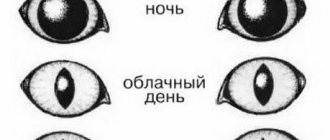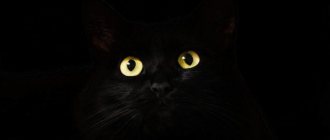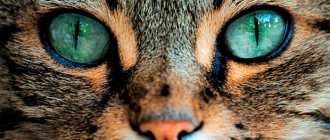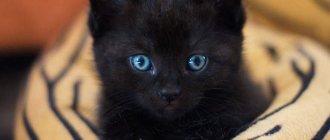Home » Useful Information
From time immemorial, the bewitching look of a cat has been surrounded by numerous beliefs and mystical speculations. Cats are even credited with the ability to see the other world and its inhabitants. To date, not all features of cat vision have been studied by scientists. But some information about how cats see has already been received and confirmed by experts.
- 2 How many colors can cats distinguish?
- 3 How far can he see?
- 4 How they see in the dark
- 5 What is the connection with the other world?
- 6 How they see our world
6.1 Do they see the image on TV and their reflection in the mirror?
- 6.2 How cats see humans
- 7.1 What to do if your cat begins to see poorly
Features of cat vision
The cat's organ of vision differs sharply from the human one in structure and ability to perceive space. They have large, round eyes with a convex lens. The viewing angle of space is 270 degrees.
A special feature of cats is stereoscopic vision. Each eye receives its own image of an object, which is then combined by the brain into one three-dimensional picture. As a result, the predator receives accurate information about the location of the prey and the distance to it.
Everything that the left eye sees goes to the right side of the brain and, conversely, the right eye transmits the picture to the left half
The genetic memory of a predator makes animals react to moving objects. Stationary animals are practically of no interest to them. Watching a moving object, the animal begins to actively move its head up and down: this is how the cat changes its viewing angle and focuses on the prey. This natural ability helps the predator calculate the distance to the prey down to the millimeter, which is why the cat’s jump is so accurate.
The special sensitivity of a cat's eyes is directly related to the structure of the pupil. It is located vertically and has increased elasticity. In bright light, it narrows, limiting rays from reaching the retina. Lack of lighting causes the pupil to dilate greatly, allowing more light to enter.
The sensitivity of a cat's eye is 6–8 times greater than that of a human. The reason for this is a special layer behind the retina called tapetum. It is a shell of vessels that look like mother of pearl.
How many colors can cats distinguish?
Until recently, there was an opinion that cats do not distinguish colors. It was assumed that all objects looked gray to them, similar in shades to mice. The main argument for this was that cats simply do not need color vision, because they hunt at night.
Recent research by scientists has refuted this claim. It has been proven that cats cannot distinguish only a few shades: orange, brown, red, green. Their eyes can see blue, violet, gray, and yellow colors. This perception is based on an increased number of cones in the eye, which decipher blue and green colors. There are practically no cones sensitive to shades of red in the eyes of these animals. Therefore, red colors are not available to cats.
Basically, the world from a cat's point of view looks bluish-gray, since they perceive purple and yellow colors less well.
There is no bright picture before the cat’s eyes, but her world is by no means gray
Interesting facts about color vision
Interestingly, color vision does not begin to develop immediately after birth, but only in the sixth month of life. It has been scientifically proven that all children are born with color blindness. This is not a pathology if color perception returns to normal after six months. Moreover, according to statistics, every 255 girls and every 12th boy have color blindness (the inability to distinguish colors).
From a physics point of view, only three colors are primary: red, green and blue, and the rest are the result of their combination in one order or another. It is believed that the human eye perceives only seven primary colors: blue, red, orange, green, yellow, violet and cyan. At the same time, we see up to 10 million different shades, including only 500 variations of gray.
Scientists have proven that our retina is not able to distinguish red, despite the presence of cones responsible for the perception of this spectrum. These receptors only detect yellow-green and blue-green colors. The brain then combines these signals and turns them into red.
Vision differs significantly between women and men. It has been proven that the fair half of humanity is able to recognize many more different shades, while representatives of the stronger sex can concentrate on a specific object for a longer time and recognize moving objects better. There is a rare genetic mutation that causes an extra cone cell to be present on the retina of women. Thanks to this, they perceive up to 100 million colors.
In addition to humans, reptiles and birds have good color vision. When conducting research, not three, but four types of cones were discovered in their retinas, so most of these animals are tetrachromats, capable of distinguishing millions of shades. Unlike us, birds perceive ultraviolet color. However, the vision of dogs and cats is limited to only two color spectrums: blue and red. Sea creatures see the world primarily in red hues.
Since childhood, we are accustomed to thinking that the sun is yellow. However, during the research process it was proven that it is a black space object. The thing is that a person distinguishes not only the wave spectrum, but also the temperature of light: the lighter the object, the warmer its emission spectrum. We see the sun as yellow because this star absorbs surrounding light without reflecting it off its surface.
Scientists have proven that with age, the human world partially dims and turns yellow, which is associated with a change in the optical properties of the eye, due to which the cones begin to perceive blue color worse. This phenomenon can be easily noticed if you study the paintings of artists that were painted in their youth and at a more mature age.
Interesting facts about the vision of a person of color:
- Children are born with color blindness. Color perception is normalized only after six months;
- Every 255 girls and every 12th boy are color blind;
- Color vision differs significantly between women and men (women perceive more shades);
- The retina of the human eye is unable to distinguish the color red;
- From a physical point of view, only 3 shades are basic: red, green, blue;
- In addition to humans, reptiles and birds have good color vision;
- The sun is a black cosmic object. We see it yellow because the star absorbs surrounding light rays;
- With age, the human world partially dims and turns yellow due to changes in the optical properties of the eye.
How far can he see
The maximum distance at which a cat can clearly see objects is 60 meters, but to him an image at such a distance looks like a solid blur. The range of vision is limited to a distance of 20 meters. Scientists explain this feature by the fact that the predator hunts from an ambush, and there is no need to distinguish distant objects.
At too close a distance, cats also do not perceive what is in front of their eyes. An object brought closer to the muzzle than 50 cm is recognized by the animal’s senses of touch. This feature should be kept in mind when playing with your pet.
Domestic predators most clearly see objects located at a distance of 75 cm to 6 m. They need this value to calculate the height and length of the jump for prey.
Sonya and TV
There was a program about the inhabitants of the African savannah. A lioness appeared on the screen hunting an antelope. Sonya suddenly interrupted her game with Tux and began to look at the TV screen. She was very empathetic to her distant relative until she overtook the victim and stabbed her to death.
Then the lioness brought the antelope to her cubs, and they began to play with it. Sonya wanted to take part in the game and jumped onto the bedside table where the TV was. At this time, the camera showed the head of the family - a handsome lion. Sonya quickly jumped away from the screen and began to watch from a distance. She sat near the TV for about an hour, reacting to all the dramatic events happening on the screen.
From then on, every week when we watched the Discovery Channel, Sonia would settle into her seat and watch the entire animal program from start to finish. We placed a chair in front of the TV screen, she sat down opposite and sat, as if sewn, constantly looking at the screen. She especially liked programs about vertebrates, sea inhabitants and birds. Several times she tried to catch the bird, but it successfully “escaped” by fleeing from the unlucky hunter.
Once Tux tried to join his inquisitive girlfriend. He jumped on a stool (Sonya moved) and stared at the screen. But his patience only lasted for a couple of minutes, after which he left and got busy with more important matters. Sonya, again comfortably settled in her workplace, continued to watch an exciting series from the life of wild relatives.
How they see in the dark
The idea that cats navigate in pitch darkness is a myth. The animal sees in minimal light. A cat only needs 10% of the lighting that a human needs. People cannot see anything in such illumination. But this animal is a predator, so its eyes are equipped with additional receptors that have increased sensitivity to light. The tapetum on the back wall of the retina, like a mirror, reflects light twice, which is why cats' eyes glow so much in the dark. In fact, the eyes do not glow, but reflect the rays that hit them.
Cats look at us with multi-colored eyes. Colors like yellow amber, blue sea, blue sky, green grass or bright gold
Good orientation in the space of a dark room is explained by the fact that vision is not the only organ with which cats perceive the world. The secret of the animal is in the especially sensitive organs of touch - vibrissae.
Vibrissae (whiskers) are unique sensors that send information about surrounding objects to the cat’s brain.
What is the connection with the other world?
Cats often observe objects that are not visible to humans. They suddenly jump up and start running around the room, knocking them over. At such moments, the animal’s pupils are dilated and its fur stands up. This behavior makes one believe that the cat sees the other world and its inhabitants. His gaze is accessible to what a person is unable to see.
When an animal looks into emptiness or, turning its head, examines an empty wall, there is no reason to worry. This is explained by the fact that even the quietest sounds that are alarming are accessible to a cat’s hearing. They do not come from the other world, but, quite possibly, from under the baseboard. The grandmothers’ assertion that at such moments the domestic predator communicates with the brownie is also from the realm of half-fairy tales.
Over the centuries, cats have been the source of scary stories thanks to their ability to see in the dark.
But the cat’s connection with a world unknown to man still exists. If your pet begins to behave restlessly, for no apparent reason, it is advisable to consecrate the home. Esotericists claim that a cat, having noticed an otherworldly body on its territory, tries to protect its owner from it. First, the animal freezes, trying to assess the “alien”’s intentions. If the cat thinks that the uninvited guest is dangerous for the owner, she tries to force him out with her own energy. When the danger is too strong and the cat cannot cope with it, it may even leave the house. It is not uncommon for cats to return as unexpectedly as they left. So the pet removes evil spirits from the home, and after getting rid of it outside the walls of the house, it returns.
Scientists do not see anything mystical in this behavior of cats and claim that any behavior of a cat is explained by its increased sensitivity to sounds and smells.
But no evidence has been presented to refute the ability of cats to see the inhabitants of the other world, so you can still believe in the supernatural power of a cat’s vision.
What to do if a cat gets electrocuted?
Electric shock can lead to the death of a pet, and therefore owners need to try to prevent this scenario. To avoid electric shock, you need to follow a few tips:
- systematically check the integrity of the sheaths of electrical wires that pass in places accessible to the pet;
- wires and sockets without insulation should not be left unattended, even for a short period of time;
It is advisable not to leave cats, especially kittens, alone with sockets and wires
If a cat is electrocuted, you need to take a number of precautions:
- you cannot touch the cat with your bare hands;
- there is no need to pick up the cat if it lies motionless;
- Don’t give in to panic—a quick response can save the animal’s life.
The main assistants in emergency situations are calmness and clarity of mind.
Procedure for dealing with an electric shock to a cat
- Disconnect the damaged cord from the power source. This should be done with a wooden object or wearing special gloves;
- Move the wire away from the pet using a wooden squeegee. Do not touch your pet with your hands under any circumstances;
- If the pet does not react to the sound and does not move, you need to lift it by its hind legs, head down, and spin around its axis, as if playing with a child. This can provoke a rush of blood to the brain;
If your pet does not regain consciousness, it is important to restore blood flow to the brain.
Most cat owners are hardly aware of the rules of providing first aid to their pets. Meanwhile, no one is immune from emergencies, so a brief excursion into the principles of artificial respiration will be useful.
Performing artificial respiration on a cat
Most often, owners of kittens encounter electric shocks. Adult cats are much less likely to show interest in live cables.
It will be much more difficult for a kitten’s fragile body to cope with an electric shock than for an adult cat’s body.
The destructive effects of electricity can affect the functioning of the central nervous system. As a result, cats may experience respiratory paralysis, changes in cardiac function, and burns.
How they see our world
To see our world through the eyes of a cat, you need to look at a faded, blurry photograph. Nature has provided for the ability of predators to clearly see moving prey without paying attention to small details. A cat's eyes do not provide a complete picture of the world, so their vision is supplemented by other senses.
Cats see immediately with their eyes, nose and vibrissae - sensitive organs located on the face and tail. It is much more important for them to touch and smell an object than to just see it.
Do they see the image on TV and their reflection in the mirror?
Scientists are divided on the perception of images on a TV screen. Some argue that animals see flickering and movement of objects. To confirm this, many owners testify that their pets love watching animals on the screen, and after switching the channel they immediately lose interest in the TV.
Cats not only love to watch TV, but also sleep on it.
Others are sure that TV programs in the eyes of animals look like static pictures replacing each other. They explain this fact by the fact that cat's eyes perceive images at a speed of 40 frames per second. In this case, the TV is configured for human perception, that is, 24 frames. For an animal to see movement on the screen, the frame must be updated 50 times per second.
In the mirror, the cat sees itself normally, but begins to hiss and flatten its ears. This behavior indicates fear. The image without odor and auditory vibrations is incomprehensible and causes fear.
How cats see humans
Pets see people as they are. They adequately assess height, recognize movements and voice. But animals see a clear picture only at a distance of 0.5 to 5 meters. At a distance of 7–10 meters, the pet sees only a silhouette and can recognize the owner by smell and voice.
There is an opinion that, in addition to the physical body of a person, cats can see his biofield. This ability can explain different attitudes towards strangers. The animal approaches some without fear, allows itself to be petted, and even goes into your arms. He doesn't let some strangers come close to him. The animal evaluates a person's aura and accurately determines who may pose a danger to him.
The ability to see the aura is reflected in the cat’s ability to identify a sore spot on the owner’s body. The pet draws out the negative energy of the owner, thereby having a beneficial effect on his health.
If a cat living in a house is constantly sick and no treatment helps, the owners should think about their own health.
By the way a domestic predator looks at a person, you can understand what his mood is at the moment and guess his desires:
- peace and tranquility is expressed by squinting eyes and constricted pupils;
- fear is reflected in wide open eyes and maximally dilated pupils;
- when the pet intends to beg the owner for a treat, the gaze becomes intent, straight into the person’s eyes;
- if an animal, without looking away, looks at a person, periodically slowly closing its eyes, it expresses its love.
The main driver is curiosity
Like any living beings, cats have an orientation instinct. When a new sound or an unfamiliar object appears in their field of vision, they instantly become wary. And if circumstances allow, they carefully observe a suspicious phenomenon - what to expect from it?
Free-ranging village cats have no shortage of variety of experiences. Either a sparrow will perch on the fence, then a careless mouse will poke its head out of the treasured hole, or even the neighbor’s dog will break loose from its chain - and don’t yawn in time to jump into a tree!
A completely different life for the pampered domestic purr. In an apartment there are neither real dangers nor the opportunity to hunt real game. But nature demands its way, and cats begin to look for new experiences on television.
Virtual hunt
If you look closely at a pet who is “stuck” watching TV, you will see how the cat moves its eyes and moves its ears. Her mustache points forward, indicating obvious interest. At the climactic moments, movements of the tail are added to other gestures and facial expressions - the cat knocks it on the sofa.
Do cats watch TV the same way as their owners? It is clear that when watching films and programs, animals are not able to perceive the same amount of information as a person. However, they react to the slightest changes in the picture and happily follow moving objects, which they perceive as potential prey.
Inexperienced, tailed TV viewers even try to catch some particularly nimble character with their paws. However, cats are too intelligent to fall into this trap more than a couple of times.
Pets quickly realize that there is an invisible but impenetrable barrier between them and the desired prey, which means there is no point in wasting their energy. Next time the cat will not bother itself with unnecessary body movements, but will not stop watching the change of frames.
Interests and preferences
Now you know why cats watch TV. What programs are their favorite?
Researchers from Lancashire University have found that cats distinguish between animate and inanimate objects moving on a screen. The flight of the ball does not arouse their interest, but they are ready to watch the football players who kick the ball around the field for so long until they get tired of it.
Another surprising discovery: cats distinguish drawn characters from living beings filmed on camera, and make a choice not in favor of cartoons. Small predators process visual information faster than people, so the movements of cartoon characters seem unnatural to a cat. Which means they don’t arouse interest.
Like dogs, cats take special pleasure in watching programs where people like them are shown. Programs about the life of wild cats or videos with stories about the antics of their domesticated counterparts are definitely beyond competition.
On domestic television, there was even an attempt to create advertising aimed specifically at cats. However, the idea failed: the TV signal does not transmit smells, and our little brothers perceive the world not only through vision, but also through smell.
In addition, cats love to watch TV during sports broadcasts with running, jumping and fast-changing pictures. However, there are no rules without exceptions: there are cats who, together with their owners, are fond of watching leisurely TV series and movies without flashy action. It used to be that pets were just lying on the couch for company, but in fact, they actually follow the movements on the screen with their eyes, even if they doze off from time to time.
Vision problems: how to notice them
Cats suffer from various vision disorders quite often. The owner should be wary if the animal hides its eyes from bright light or often rubs its face with its paws. Signs of inflammation are frequent blinking of the pet, pus in the corners of the eyes, clouding of the whites, swelling of the eyelids. Any of these signs is a reason to immediately consult a veterinarian.
Kittens that are blind at an early age have much longer whiskers than their kittens. This is how nature compensates for the lack of visual perception of the world
Some eye diseases can cause complete blindness in your pet. It is difficult to notice vision problems in cats in order to take timely measures, since they are able to navigate in space even with complete blindness. The following signs indicate that vision problems have begun and should be checked:
- the animal does not jump to its favorite places located at a height or, when jumping, misses and falls;
- when moving around the house, he comes across moved or new furniture, objects standing in unusual places;
- your pet’s pupils do not constrict in bright light;
- stops responding to favorite toys;
- when the pet looks at the owner, his gaze does not focus on him.
All these signs indicate a deterioration in the cat’s vision or the onset of blindness.
What to do if your cat begins to see poorly
Unfortunately, it is not always possible to restore a pet’s vision, but this is not a reason to abandon a sick animal. The owner should organize the space of the home in such a way that the animal feels comfortable. Your pet can live a full life if you do the following:
- do not change the location of bowls with food and water;
- do not let the animal out into the street unattended, take it for a walk on a leash;
- in a new room, accustom the cat to the location of objects, without frightening them and allowing them to find their own way;
- do not block the path with boxes, scattered toys and other objects.











